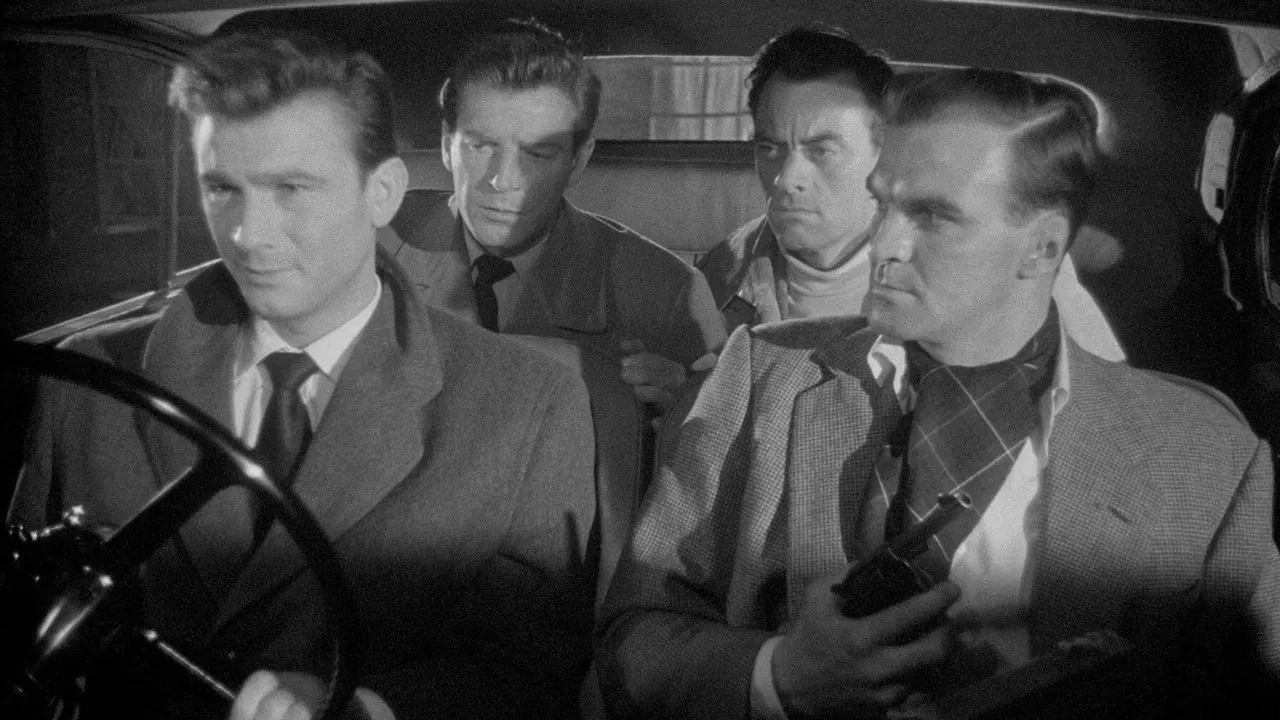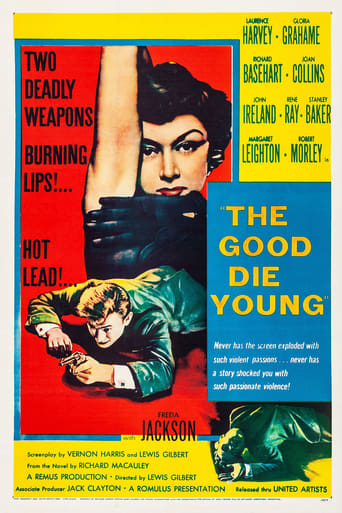

"The Good Die Young" is a 1954 British film with an impressive cast consisting of Laurence Harvey, Stanley Baker, John Ireland, Richard Basehart, Joan Collins, Margaret Leighton, and Gloria Grahame.The four men band together to commit a robbery, though they're not experienced criminals - just three men down in their luck and desperate, and one snake (that would be Harvey). Richard Basehart plays Joe, whose wife Mary left for England to visit her sick mother and hasn't returned. Her mother is the type that has attacks whenever Mary says she's going home. Meanwhile, she's pregnant and he has to get her back to America, but since he's quit his job, he needs money.John Ireland is Eddie, who is married to an actress (Grahame). She is so busy on the set (and with her costar) that he goes AWOL to have time with her. By the time he realizes she's not worth it, it's too late.Stanley Baker is Mike Morgan, who loses his gangrenous hand after a boxing match, and needs money to live on.Laurence Harvey is a worm married to a wealthy woman (Leighton) who refuses to pay his gambling debt and wants him to move to Africa with her. He comes up with the idea of the robbery and convinces the others.This has the look and feel of a British B picture from the era and there really isn't anything exceptional about it. It's not as suspenseful as it could have been, though it isn't bad. It's worth seeing for these young actors, and indeed, Harvey, Baker,Leighton, and Graham did die young, sadly. The only one today still with us is the indomitable Joan Collins, now 79.Worth a look.
... View MoreA well crafted heist thriller of the old school with the message of crime doesn't pay about a quartet of ne'er-do-wells who's stories are told in flashbacks then culminates in the daring crime which in turns leads to divisions amongst them.The leader is Miles(Rave)Ravenscourt(Laurence Harvey)who's at his gleefully sneering best with a host of well known faces(Baker,Basehart&John Ireland,there's also a young Joan Collins as Basehart's wife along with Gloria Grahame who's wonderful as a spoilt married woman to one of the gang.Full of action towards the end especially the underground scenes,the cast includes Margaret Leighton who was Harvey's real life wife.
... View MoreChannel 4 recently screened The Good Die Young one afternoon so I set the video and was pleased I did.Four men, a boxer who has had one of his arms amputated, a rich man and two Americans are fed up of being short of money. The rich man suggests the four of them rob a post office which is having a delivery of £90,000 later that evening. After all agreeing, they head there but things start going wrong when a copper comes over to their car to tell them are illegally parked. He is shot dead and the gang the raid the van and take the money and escape into a nearby church yard. The rich man shoots the boxer first after he decides to give himself up, then as they are crossing the railway lines which are electrified, he pushes one of the Americans onto the live rails and is electrocuted. The two survivors manage to escape further from the police on an Underground train but the American decides he has had enough and goes back to his wife and they head to the airport to go catch a flight back to America. After making a last minute phone call to police telling them where the hidden money is, the rich man sees him in the phone booth but he is shot by the American. Thinking he is dead, he heads for the plane but is shot and then collapses into his wife's arms and dies. A sad ending.The movie has excellent location photography around London and one of the best parts is the railway sequence.This movie is worth having in a collection just for the cast: the gang leader is played by Laurence Harvey, the boxer is played by Stanley Baker (Zulu), the Americans are Richard Basehart (Voyage to the Bottom Of the Sea) and John Ireland. The rest of the cast includes a young Joan Collins (Empire of the Ants, Dynasty), Robert Morley (who only appears too briefly), Margaret Leighton, Freda Jackson (The Valley Of Gwangi), Rene Ray and Susan Shaw.Watching this is an ideal way of spending 100 minutes one afternoon. Excellent.Rating: 4 stars out of 5.
... View MoreA cast of very good actors giving less than stellar performances in a "terribly English" crime drama about four losers banding together to rob a post office van. Contrived situations and sledgehammer dialogue doom this movie to sub-B status. What this project really needed was a scriptwriter with a sense of pace and an ear for dialogue and a strong director - neither of which it has, even though director Lewis Gilbert would indeed go on to better things. One wonders how American director Jules Dassin, who was active in this period and excelled at this kind of movie, would have handled the material - much faster, slicker and entertaining, no doubt. Joan Collins in one of her early roles - her breasts thrusting into the spotlight at every opportunity. Thank God she subsequently got her act together and took herself less seriously. A dreadful performance by the great Gloria Grahame, who played similar roles in other movies to much greater effect. Competent performances by John Ireland and Richard Basehart, despite their klunky dialogue. A showy, slimy performance by matinée idol Laurence Harvey that is waaaay too English to be convincing or believable. The one knockout performance comes from forgotten Welsh actor Stanley Baker as a washed up boxer. Vibrant, passionate, quietly effective when needed. A major talent cut short in his prime. A quality act. Overall the movie suffers from an artificial style of acting that disappeared from the British cinema in the early 60's with the emergence of the working class actors like Finney, Courtenay, O'Toole and Harris - and not a moment too soon. An interesting curiosity of a movie but could have been much better.
... View More